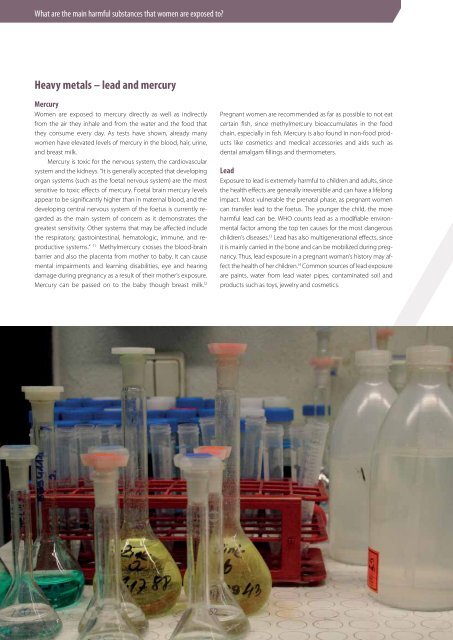Women and Chemicals
1ToENNR
1ToENNR
You also want an ePaper? Increase the reach of your titles
YUMPU automatically turns print PDFs into web optimized ePapers that Google loves.
What are the main harmful substances that women are exposed to?<br />
Heavy metals – lead <strong>and</strong> mercury<br />
Mercury<br />
<strong>Women</strong> are exposed to mercury directly as well as indirectly<br />
from the air they inhale <strong>and</strong> from the water <strong>and</strong> the food that<br />
they consume every day. As tests have shown, already many<br />
women have elevated levels of mercury in the blood, hair, urine,<br />
<strong>and</strong> breast milk.<br />
Mercury is toxic for the nervous system, the cardiovascular<br />
system <strong>and</strong> the kidneys. “It is generally accepted that developing<br />
organ systems (such as the foetal nervous system) are the most<br />
sensitive to toxic effects of mercury. Foetal brain mercury levels<br />
appear to be significantly higher than in maternal blood, <strong>and</strong> the<br />
developing central nervous system of the foetus is currently regarded<br />
as the main system of concern as it demonstrates the<br />
greatest sensitivity. Other systems that may be affected include<br />
the respiratory, gastrointestinal, hematologic, immune, <strong>and</strong> reproductive<br />
systems.“ 11 Methylmercury crosses the blood-brain<br />
barrier <strong>and</strong> also the placenta from mother to baby. It can cause<br />
mental impairments <strong>and</strong> learning disabilities, eye <strong>and</strong> hearing<br />
damage during pregnancy as a result of their mother’s exposure.<br />
Mercury can be passed on to the baby though breast milk. 12<br />
Pregnant women are recommended as far as possible to not eat<br />
certain fish, since methylmercury bioaccumulates in the food<br />
chain, especially in fish. Mercury is also found in non-food products<br />
like cosmetics <strong>and</strong> medical accessories <strong>and</strong> aids such as<br />
dental amalgam fillings <strong>and</strong> thermometers.<br />
Lead<br />
Exposure to lead is extremely harmful to children <strong>and</strong> adults, since<br />
the health effects are generally irreversible <strong>and</strong> can have a lifelong<br />
impact. Most vulnerable the prenatal phase, as pregnant women<br />
can transfer lead to the foetus. The younger the child, the more<br />
harmful lead can be. WHO counts lead as a modifiable environmental<br />
factor among the top ten causes for the most dangerous<br />
children’s diseases. 13 Lead has also multigenerational effects, since<br />
it is mainly carried in the bone <strong>and</strong> can be mobilized during pregnancy.<br />
Thus, lead exposure in a pregnant woman’s history may affect<br />
the health of her children. 14 Common sources of lead exposure<br />
are paints, water from lead water pipes, contaminated soil <strong>and</strong><br />
products such as toys, jewelry <strong>and</strong> cosmetics.<br />
52


